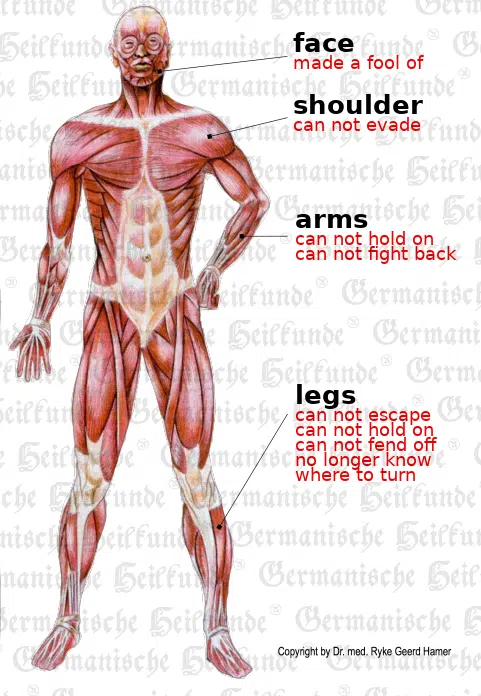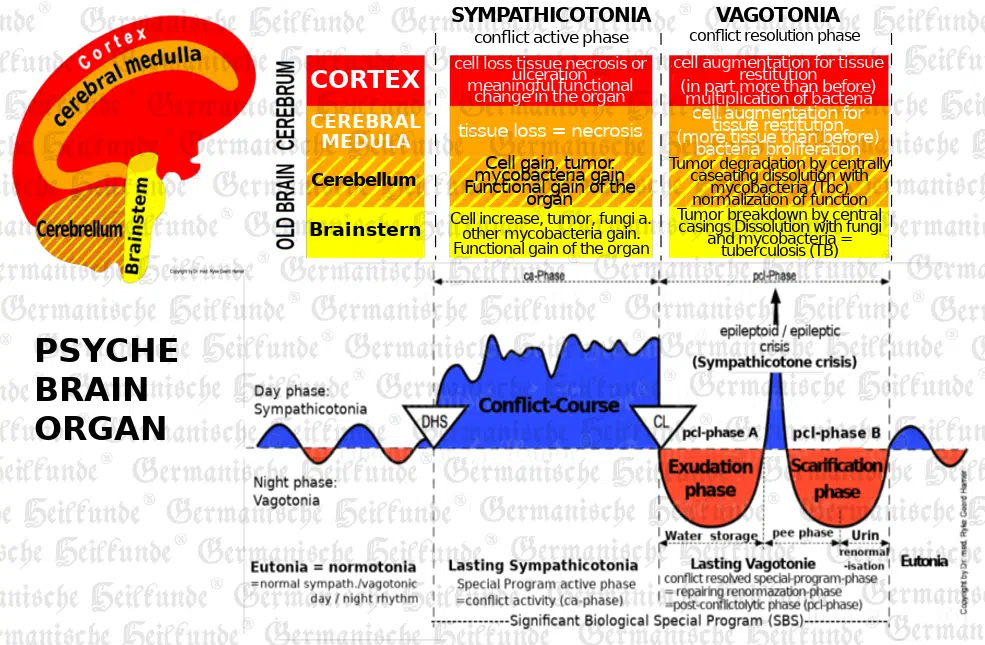Epilepsy – what it is all about
Epileptic seizure or epileptic crisis means tonic-clonic seizure at the nadir of vagotonia in the healing phase after a motor conflict. Such a conflict is always preceded by a severe conflict experience, a DHS (conflict shock). In all motor paralyzes, just as in bone skeleton or sensory paralyzes, it depends on the handedness of the affected person. For right-handed people, all the muscles on the right have to do with partners, and all the muscles on the left have to do with children or their own mothers. In left-handers, everything is the other way around. In the case of bilateral paralysis, both groups have always been involved in the DHS, at least in their thoughts. The only exception is when a particular muscle is affected locally, e.g., in an accident. Of course, this has nothing to do with children, partners, or one’s own mother.
The unique conflict content is the conflictive fear of not being able to escape or avoid someone. For example, a small child suffered a motor conflict during a vaccination when he was restrained with a towel and could not move or escape.

For example, the right-handed person pushes the partner away with the extensor side of the leg. With the flexor side, he embraces him. Depending on the motor conflict’s intensity, the motor paralysis increases, i.e., no motor code goes out as long as there is conflict activity. Single muscles, muscle groups, or whole limbs can be affected.
The great danger then is always that patients usually suffer a second motor conflict – mainly of the legs – due to the diagnosis shock because they are told that they will possibly be confined to a wheelchair for the rest of their lives. e.g., in the case of a diagnosis of multiple sclerosis. Patients then usually never resolve this conflict.
Children born with paralysis have also suffered severe conflict DHS intrauterine that has impacted the motor center. By far, the most common embryonic conflict here is the circular saw conflict.
We, humans, have innate codes just like animals. We have lived in the same earth zone as the lion or other predators for millions of years. The roar of the lion is an alarm signal for us humans. This is innate to us and even an embryo recognizes the lion’s roar and becomes thoroughly restless. The circular saw imitates approximately the roar and snarl of a predator.
In our civilization, pregnant women have mostly lost their instincts. She can stand unsuspectingly next to a running circular saw, and she may even saws along herself, not suspecting that the child in her womb is getting into a terrible panic because it cannot assume anything other than that the mother will be eaten by the lion in the next moment – together with the embryo. And so, we see motor or sensory paralysis or both combined after birth. Our brain simply does not have these sounds of civilization in its program yet. Still, it associates them with the dangers that are deprogrammed into our program because of our phylogenetic adaptations. The DHS is always the beginning of the conflict-active phase and also the beginning of any disease. Therefore, it is important to always return to the DHS. Every disease that has conflict resolution also has a ca-phase and a pcl-phase. And every pcl-phase, unless interrupted by a conflict-active relapse, has an epileptic or epileptoid crisis at the lowest point of vagotonia.

The epileptic seizure, or the epileptic crisis as it is referred to in GHK, is more or less pronounced and dramatically characterizes every healing phase after a motor conflict, always arising based on brain edema. The epileptic or epileptoid crisis means that the edema is stopped and counter-regulated by the organism itself. So, if the motor conflict is resolved, the shooting rings in the brain get edema. As a result, the motor function in this pcl-phase (healing phase) seemingly becomes worse temporarily. Also, uncontrolled twitching sets in. Invariably, there is also an epileptic seizure with muscle spasms. Such cortical epileptic crises, originating from a HH in the cerebral cortex, may spread to the whole cortex and cause tonic-clonic convulsions, with tongue biting, foaming at the mouth, tongue flapping, etc.
In its essence, the epileptic seizure or crisis is a shock adjustment of the organism, trying to squeeze out the HH’s intra- and perifocal edema. This happens because the corresponding relay center will almost suffocate on excessive edema otherwise, which means that the function is not guaranteed. It is the turning point to renormalization, a quasi-physiological and obligatory conflict recurrence set up by nature in the middle of the healing phase, quasi-imaginary. In this epileptic crisis, the patient experiences his entire biological conflict of the conflict-active phase again in fast motion. In this way, the organism squeezes out the oedemas, and the renormalization with diuresis (peeing phase) can be approached. From then on, the organism strives back to normalization. i.e., after this epileptic crisis, the muscle innervation slowly returns.
The old idea that brain cells would be destroyed during these epileptic seizures was erroneous and only that the affected Hamer Focus (HH) in the brain becomes increasingly scarred. This is also the case with frequent recurrences of all other Sensible Biological Special Programs (SBS). Incurious and simple-minded brain surgeons tried to operate out the “epileptic foci” almost everywhere. This invariably led to irreparable paralysis of the affected muscle groups and also to scarring epilepsies. Suppose a patient has two motor conflicts on each of the two hemispheres. In this case, he is not only in a schizophrenic constellation, but he also has a motor delusion, i.e., he has a tick, which has to do with the conflict again. If we know both DHS, then we understand the tick.
Except for biological motor conflicts that have an epileptic crisis in the pcl-phase, all medical diseases have an epileptoid crisis. Epileptoid means epilepsy-like. There are no tonic-clonic seizures in epileptoid crises, as in motor conflicts. Still, each biological conflict type and disease type has its particular type of epileptoid crisis. In sensory conflicts, the conflict content is the fear of not feeling, which is usually fatal in nature, and then in further “body contact loss fear” or “abandonment fear.”
Nature has refined this shock state, epileptoid crisis, for millions of years, along with its therapy. Every disease has its very specific pcl-symptoms, which start with conflict resolution. We call this short phase of the turning point or the beginning of the counter-regulation epileptic or epileptoid crisis. In the case of coronary ulcer cancer, we call it myocardial infarction. At the same time, we do not fail to recognize that the healing phases also have their dangers.
In the case of myocardial infarction, for example, if the conflict lasts for more than nine months, as our Vienna myocardial infarction study has shown, the chances of survival decrease quite significantly according to the current state of conventional medical treatment. The patients in this study always had their epileptic crisis 3 to 6 weeks after the conflictolysis/crisis. Not a single patient survived who had a territorial conflict lasting longer than nine months. However, “normal” conflict activity is a prerequisite.
The chances of survival can be increased considerably if treatment can be started in advance, i.e., in the 3-6 weeks of vagotonia before the epileptoid crisis or heart attack. Cortisone and cooling of the head can be used to slow down the cerebral edema. In this way, myocardial infarction mortality can be easily reduced to less than half.
Every influx of edema in the healing phase has its peak or so-called turning point. If the patient has survived this crisis and the condition remains stable, i.e., without panic and without conflict recurrence, then the patient has usually largely overcome his entire illness.
The pcl-phase generally involves far more significant difficulty for the physician than the ca-phase. Not only do we have to teach the patient that the symptoms previously presented to him as bad are now to be welcomed in most cases, but there are also real medical crises to survive. For example, let us think of the first phase of the leukaemic cure or the epileptoid crisis. It presents us with a new challenge in terms of medication because we had previously misunderstood them. Because of all the batteries of medications that every patient in a hospital receives today, no doctor usually knows anymore what, when, where, and how the medications work. One had been completely mistaken – in principle!
In the Germanische Heilkunde®, quite exact criteria were found for it, e.g., typical conflict-active symptoms on psychological, cerebral, and organ levels. These are quite typical symptoms of the healing phase, likewise on psychic, cerebral, and organ levels. In addition, there are the typical symptoms on all three levels in the epileptic or the epileptoid crisis, which are a little different for each disease, but again also typical for each disease in particular, concerning the cerebral and organic symptoms, and of course,, typical anyway for the psychic and the vegetative symptoms.
The epileptic or epileptoid crisis is the most dangerous moment in the course of the biological conflict in many cortical cerebral conflicts. e.g., myocardial infarction, pulmonary embolism, pneumonic lysis, absence after separation conflict, etc. In some courses of disease, even the pcl-phase is much more dangerous than the conflict-active phase. Its preventive weakening is therefore of decisive importance. Germanische Heilkunde® is a strict, logical-coherent natural science. Still, at the same time, it is also the most human and responsible for all sciences, easy to understand for patients and doctors alike. It is based solely on only five biological laws of nature – in contrast to the previous hypothesis of medicine.
Copyright Dr. Hamer
Translated: John Holledauer
TODAY: 78
LAST 30 DAYS: 3.016
THIS YEAR: 33.749
TOTAL: 152.864
| Cookie | Duration | Description |
|---|---|---|
| cookielawinfo-checkbox-analytics | 11 months | This cookie is set by GDPR Cookie Consent plugin. The cookie is used to store the user consent for the cookies in the category "Analytics". |
| cookielawinfo-checkbox-functional | 11 months | The cookie is set by GDPR cookie consent to record the user consent for the cookies in the category "Functional". |
| cookielawinfo-checkbox-necessary | 11 months | This cookie is set by GDPR Cookie Consent plugin. The cookies is used to store the user consent for the cookies in the category "Necessary". |
| cookielawinfo-checkbox-others | 11 months | This cookie is set by GDPR Cookie Consent plugin. The cookie is used to store the user consent for the cookies in the category "Other. |
| cookielawinfo-checkbox-performance | 11 months | This cookie is set by GDPR Cookie Consent plugin. The cookie is used to store the user consent for the cookies in the category "Performance". |
| viewed_cookie_policy | 11 months | The cookie is set by the GDPR Cookie Consent plugin and is used to store whether or not user has consented to the use of cookies. It does not store any personal data. |
You’ll be informed by email when we post new articles and novelties. In every email there is a link to modify or cancel your subscription.